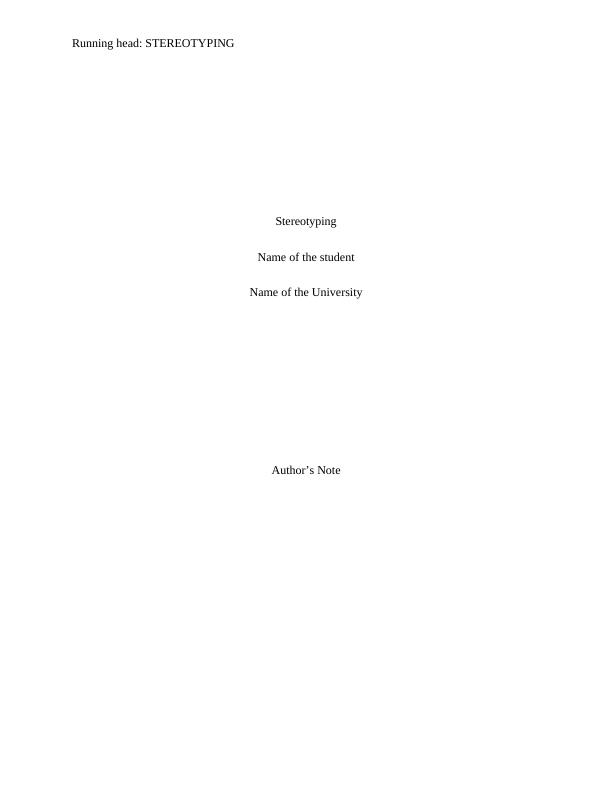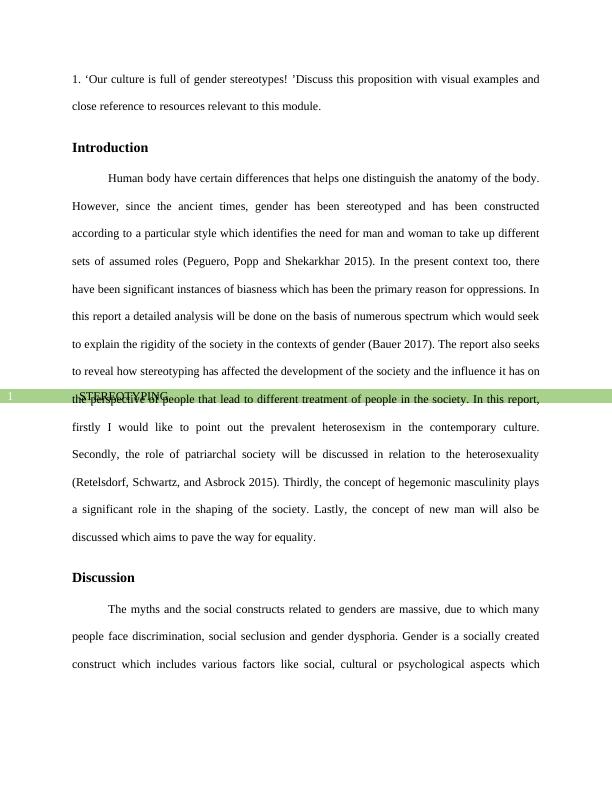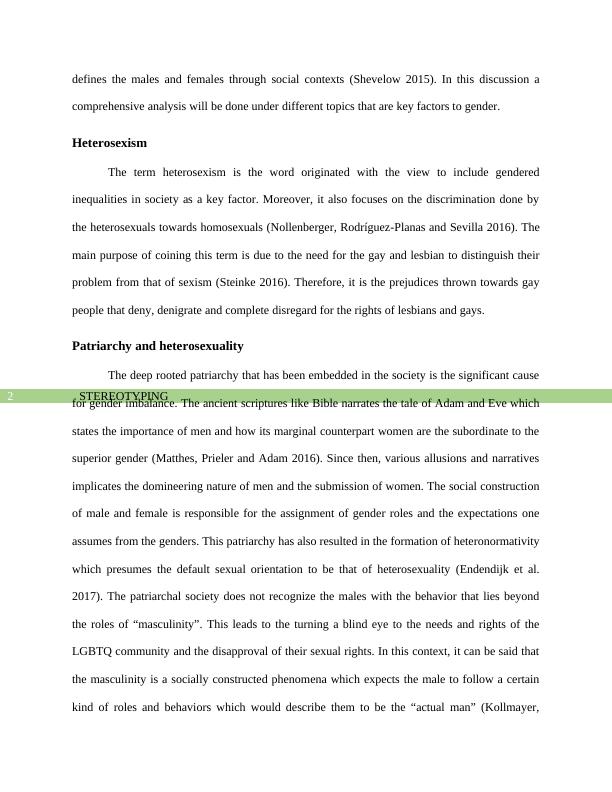Journal of interpersonal violence
Training and Leadership Development Volunteer for Teach For Sierra Leone
13 Pages2619 Words13 Views
Added on 2022-09-11
Journal of interpersonal violence
Training and Leadership Development Volunteer for Teach For Sierra Leone
Added on 2022-09-11
ShareRelated Documents
Running head: STEREOTYPING
Stereotyping
Name of the student
Name of the University
Author’s Note
Stereotyping
Name of the student
Name of the University
Author’s Note

STEREOTYPING1
1. ‘Our culture is full of gender stereotypes! ’Discuss this proposition with visual examples and
close reference to resources relevant to this module.
Introduction
Human body have certain differences that helps one distinguish the anatomy of the body.
However, since the ancient times, gender has been stereotyped and has been constructed
according to a particular style which identifies the need for man and woman to take up different
sets of assumed roles (Peguero, Popp and Shekarkhar 2015). In the present context too, there
have been significant instances of biasness which has been the primary reason for oppressions. In
this report a detailed analysis will be done on the basis of numerous spectrum which would seek
to explain the rigidity of the society in the contexts of gender (Bauer 2017). The report also seeks
to reveal how stereotyping has affected the development of the society and the influence it has on
the perspective of people that lead to different treatment of people in the society. In this report,
firstly I would like to point out the prevalent heterosexism in the contemporary culture.
Secondly, the role of patriarchal society will be discussed in relation to the heterosexuality
(Retelsdorf, Schwartz, and Asbrock 2015). Thirdly, the concept of hegemonic masculinity plays
a significant role in the shaping of the society. Lastly, the concept of new man will also be
discussed which aims to pave the way for equality.
Discussion
The myths and the social constructs related to genders are massive, due to which many
people face discrimination, social seclusion and gender dysphoria. Gender is a socially created
construct which includes various factors like social, cultural or psychological aspects which
1. ‘Our culture is full of gender stereotypes! ’Discuss this proposition with visual examples and
close reference to resources relevant to this module.
Introduction
Human body have certain differences that helps one distinguish the anatomy of the body.
However, since the ancient times, gender has been stereotyped and has been constructed
according to a particular style which identifies the need for man and woman to take up different
sets of assumed roles (Peguero, Popp and Shekarkhar 2015). In the present context too, there
have been significant instances of biasness which has been the primary reason for oppressions. In
this report a detailed analysis will be done on the basis of numerous spectrum which would seek
to explain the rigidity of the society in the contexts of gender (Bauer 2017). The report also seeks
to reveal how stereotyping has affected the development of the society and the influence it has on
the perspective of people that lead to different treatment of people in the society. In this report,
firstly I would like to point out the prevalent heterosexism in the contemporary culture.
Secondly, the role of patriarchal society will be discussed in relation to the heterosexuality
(Retelsdorf, Schwartz, and Asbrock 2015). Thirdly, the concept of hegemonic masculinity plays
a significant role in the shaping of the society. Lastly, the concept of new man will also be
discussed which aims to pave the way for equality.
Discussion
The myths and the social constructs related to genders are massive, due to which many
people face discrimination, social seclusion and gender dysphoria. Gender is a socially created
construct which includes various factors like social, cultural or psychological aspects which

STEREOTYPING2
defines the males and females through social contexts (Shevelow 2015). In this discussion a
comprehensive analysis will be done under different topics that are key factors to gender.
Heterosexism
The term heterosexism is the word originated with the view to include gendered
inequalities in society as a key factor. Moreover, it also focuses on the discrimination done by
the heterosexuals towards homosexuals (Nollenberger, Rodríguez-Planas and Sevilla 2016). The
main purpose of coining this term is due to the need for the gay and lesbian to distinguish their
problem from that of sexism (Steinke 2016). Therefore, it is the prejudices thrown towards gay
people that deny, denigrate and complete disregard for the rights of lesbians and gays.
Patriarchy and heterosexuality
The deep rooted patriarchy that has been embedded in the society is the significant cause
for gender imbalance. The ancient scriptures like Bible narrates the tale of Adam and Eve which
states the importance of men and how its marginal counterpart women are the subordinate to the
superior gender (Matthes, Prieler and Adam 2016). Since then, various allusions and narratives
implicates the domineering nature of men and the submission of women. The social construction
of male and female is responsible for the assignment of gender roles and the expectations one
assumes from the genders. This patriarchy has also resulted in the formation of heteronormativity
which presumes the default sexual orientation to be that of heterosexuality (Endendijk et al.
2017). The patriarchal society does not recognize the males with the behavior that lies beyond
the roles of “masculinity”. This leads to the turning a blind eye to the needs and rights of the
LGBTQ community and the disapproval of their sexual rights. In this context, it can be said that
the masculinity is a socially constructed phenomena which expects the male to follow a certain
kind of roles and behaviors which would describe them to be the “actual man” (Kollmayer,
defines the males and females through social contexts (Shevelow 2015). In this discussion a
comprehensive analysis will be done under different topics that are key factors to gender.
Heterosexism
The term heterosexism is the word originated with the view to include gendered
inequalities in society as a key factor. Moreover, it also focuses on the discrimination done by
the heterosexuals towards homosexuals (Nollenberger, Rodríguez-Planas and Sevilla 2016). The
main purpose of coining this term is due to the need for the gay and lesbian to distinguish their
problem from that of sexism (Steinke 2016). Therefore, it is the prejudices thrown towards gay
people that deny, denigrate and complete disregard for the rights of lesbians and gays.
Patriarchy and heterosexuality
The deep rooted patriarchy that has been embedded in the society is the significant cause
for gender imbalance. The ancient scriptures like Bible narrates the tale of Adam and Eve which
states the importance of men and how its marginal counterpart women are the subordinate to the
superior gender (Matthes, Prieler and Adam 2016). Since then, various allusions and narratives
implicates the domineering nature of men and the submission of women. The social construction
of male and female is responsible for the assignment of gender roles and the expectations one
assumes from the genders. This patriarchy has also resulted in the formation of heteronormativity
which presumes the default sexual orientation to be that of heterosexuality (Endendijk et al.
2017). The patriarchal society does not recognize the males with the behavior that lies beyond
the roles of “masculinity”. This leads to the turning a blind eye to the needs and rights of the
LGBTQ community and the disapproval of their sexual rights. In this context, it can be said that
the masculinity is a socially constructed phenomena which expects the male to follow a certain
kind of roles and behaviors which would describe them to be the “actual man” (Kollmayer,

STEREOTYPING3
Schober and Spiel 2018). This is due to this reason that the effeminate behavior of men is not
considered normal. Not only that, but certain other expectations are demanded from men which
is not “feminine”. These assumptions of behavior and roles are certainly derogatory and plays a
great role in the way it affects the development of the society (Young 2016). The perspective of
the generations are also effected in this way and the normalcy of the ideas where the women
should belong to the kitchen and the men’s job is to fulfil the monetary demands of the family is
the only accepted way of existence.
The idea of masculinity is also promoted by the advertisement and the media which tells
one the particular way to be male (Walton, Lykins and Bhullar 2016). Most of these
advertisements promotes the acting of men where the women is also present but the existence is
limited only for the purpose of objectification. In this way, the social construction of the ideas of
gender have a lot to do with the carrying on of the perspective of the generations to a restricted
sphere (Hyde 2016). The emphasis on heterosexuality also results in the growth of hegemonic
masculinity which is the normal and accepted nature of the inclination of this society towards
domination of men. This leads to the pressure of men by other males and the surveillance
towards them to become more masculine as for instance striving for a high salaried jobs,
muscular figure, etc. (Wasarhaley et al. 2017). In reality, there is no such masculinity or a pattern
of way to behave that would show the real way of being a man nor woman.
Schober and Spiel 2018). This is due to this reason that the effeminate behavior of men is not
considered normal. Not only that, but certain other expectations are demanded from men which
is not “feminine”. These assumptions of behavior and roles are certainly derogatory and plays a
great role in the way it affects the development of the society (Young 2016). The perspective of
the generations are also effected in this way and the normalcy of the ideas where the women
should belong to the kitchen and the men’s job is to fulfil the monetary demands of the family is
the only accepted way of existence.
The idea of masculinity is also promoted by the advertisement and the media which tells
one the particular way to be male (Walton, Lykins and Bhullar 2016). Most of these
advertisements promotes the acting of men where the women is also present but the existence is
limited only for the purpose of objectification. In this way, the social construction of the ideas of
gender have a lot to do with the carrying on of the perspective of the generations to a restricted
sphere (Hyde 2016). The emphasis on heterosexuality also results in the growth of hegemonic
masculinity which is the normal and accepted nature of the inclination of this society towards
domination of men. This leads to the pressure of men by other males and the surveillance
towards them to become more masculine as for instance striving for a high salaried jobs,
muscular figure, etc. (Wasarhaley et al. 2017). In reality, there is no such masculinity or a pattern
of way to behave that would show the real way of being a man nor woman.

End of preview
Want to access all the pages? Upload your documents or become a member.
Related Documents
Gender, Sexuality and Social Changeslg...
|9
|2590
|470
Stereotyping and Healthcare decisions: Gays and lesbianslg...
|11
|3395
|41
LGBT Community: Understanding Diversity and Promoting Inclusionlg...
|5
|1205
|150
Essaylg...
|10
|3320
|22
How Biological and Social Processes Influence Genderlg...
|8
|2399
|2
Overview of Photojounalism Assignmentlg...
|4
|662
|18
